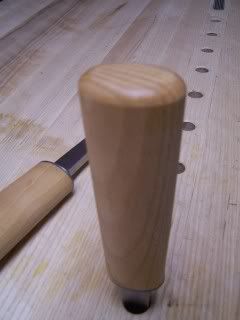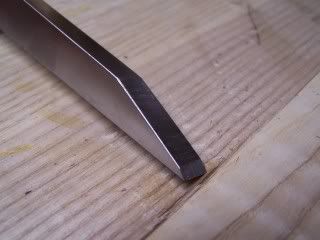God Save the Queen’s Mortising Chisels
I remember sitting in the Eight Bells pub just outside Stratford-Upon-Avon and sampling some fine sherry trifle while having a political discussion with a local about “nutter American politicians”. Our conversation eventually turned to British politics and the “royal problem”. I was very young and still really wide eyed but I remember this conversation clearly as being a watershed moment when I realized what our revolution from the crown really means more than 200 years later. I’m sure you have heard the expression, “two countries separated by a common language” and I think it sums up our relationship with our cousins across the pond. We are very much like the Brits, but often we are less refined and informal. I have traveled enough outside our borders to have encountered the ugly American epithet and this is not what I am talking about here.
Let’s look at music as an example. With thousands of years of tradition and formal structure to music, it took those crazy Americans to throw away those rules and build the Jazz art form based entirely around improvisation. In the Baroque period, the Pope banished the diminished 5th or tri-tone from music calling it il diablo en musica because of it’s harshly dissonant sound. No one would touch the interval until some crazy American named Bernstein not only used the interval but based an entire operetta, West Side Story, on the evil sound.
Americans have long been about breaking the rules and casting off societal norms. Now maybe we have gone a bit too far these days and I will be the first to admit a yearning for a simpler, more moral time. “Gee Walt, I think there’s something wrong with the Beaver”.
Our furniture was simpler and cleaner than it’s heavily carved and ornate British counterparts. Outside of the metropolitan areas, I don’t think America really left the Queen Anne or Neat & Plain period for the embellished Chippendale. While Federal was well into vogue in Europe and certainly not an American idea, we embraced wholeheartedly the return to basics that this style evokes and latched onto it as our own as a kind of metaphor for our new born republic.
These days, there is a point of pride when you say that this product was made in America (or at least North America) and there is no question that we are making some brilliant tools here on the continent. I own many of them and use them proudly.
However when it comes to mortising chisels let me just say, God save the queen and pip pip cheerio to that! This Christmas Santa sent me a pair of Ray Iles English Pattern Mortising Chisels and they are a revelation! You wouldn’t think that such a simple tool could be so vastly different. It’s a thick piece a steel crammed into a wooden handle right? Let’s take a look at the features of these chisels and what it means to you when you use them.

Handles
At first glance you will notice the handle. It is beefy and not round. I love the tactile feel of a hefty handle and the elliptical shape allows you to “register” the chisel in your hand. I have found that this helps me to position the chisel very quickly and easily merely by the feel of the tool in your hand. There is very little chance of chopping into your stuff at a crooked angle.

Bevels
As they come from England via Tools for Working Wood, the chisel are ground with a really acute primary bevel. I measured mine to be in the 20-25 degree range. This low bevel allows room for the chisel to work deep in a mortise while still providing great leveraging power along that bevel. However, this primary bevel would quickly fold under the whacking you give it while mortising. So to compensate there is a secondary bevel of 35 degrees. Notice I say secondary bevel and not micro bevel. This secondary bevel is a good 3/16″ wide to provide a solid hunk of steel to support your cutting edge. I immediately saw a great difference with the lower primary bevel. I had much more room when approaching the bottom of the mortise to move the chisel back and forth when levering out the waste.

That Crazy Odd Shape
This is something you won’t notice unless you are looking for it, but will immediately feel in use. The cross section of the blade is trapezoidal in shape with a slight wider back than front. The big reason for this is when you are buried deep in the wood a simple pull back on the handle will pop the chisel free of the mortise death grip. Most important for me is the with this slight taper you get some wiggle room when starting the cut and positioning your chisel along your marking lines. I had long believed that parallel sides were necessary to guide the chisel through the cut, but you quickly realize that this has little to no effect as the resulting mortise is determined on that first tap of the mallet. I suppose if I were making very shallow mortising this could make a difference, but for furniture work, it is rare to make a mortise shallower than 1 inch.

So far I have put these babies to the test in Poplar, Maple, Oak, Pine, Walnut, and Mahogany and there really is no appreciable difference. It is very easy to line up because of the oval handle and the trapezoidal shape allows for some flexibility in steering into the cut as you whack it with a mallet. I also have a few eBay finds that I have been using for the better part of a year and there is a difference. While based on the same pattern, the exceptional steel, more acute primary bevel, and the trapezoid shape are not found on these vintage chisels. What I find most exciting is this is a chisel that you don’t need a complete set to be effective. How many sizes of mortises do you really cut right. I have 3/8 and 1/4″ now and I can’t see needing anymore. I have a 1/2″ in my vintage set and I have used those while making my workbench.
So in conclusion, run don’t walk over to Tools for Working Wood and check these out, pour yourself a pint of bitter, put Manchester on the tele, and make some holes in your wood


